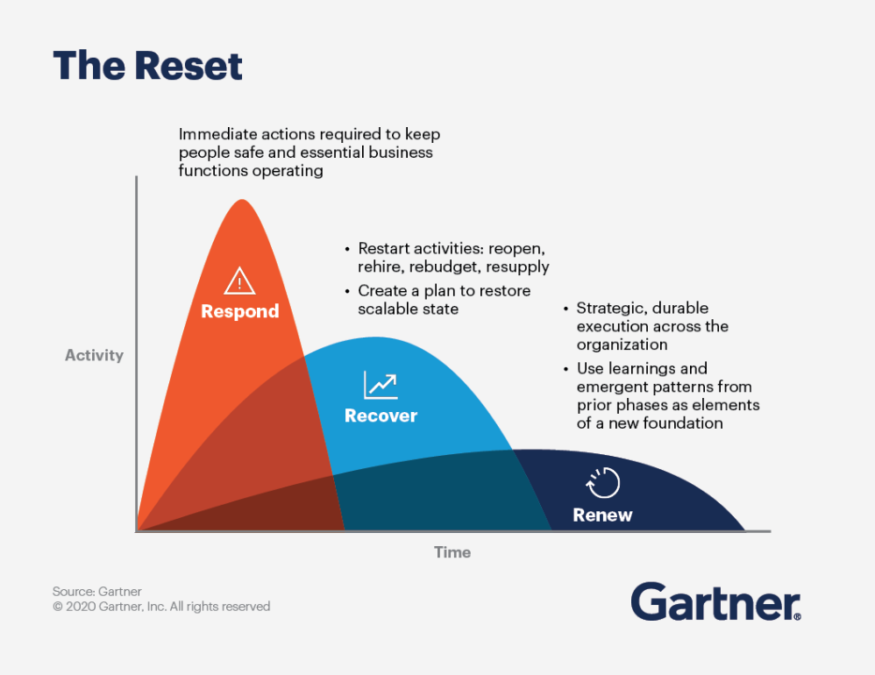As the different phases of Covid-19 pandemic progress, business leaders must reset their strategy and build resilience, according to Gartner.
The research organisation says that it is crucial for senior leaders to make strategic decisions that will lead them to a renewed future state.
“There’s been a reset of the workforce and work itself, a reset of the employer/employee relationship, and a reset of the business ecosystem. For most, the business impact of the pandemic has been deeply negative, while positive for some fortunate sectors,” said Chris Howard, chief of research at Gartner.
“The pandemic has wiped away the strategy for some leaders, but they’ve also garnered invaluable experience. Now it’s time to bring together the executive team and use those lessons to reconfigure their business and operating models for a new reality.”

3 stages to reset business strategy
Gartner has identified three stages that business leaders should follow to reset their business strategy:
1. Respond
Immediate actions are focused on keeping people safe and essential business functions operating. This is a relatively short period marked by high effort and potentially chaotic activity. Key activities include:
• Temporary fixes to stop the bleeding.
2. Recover
This is a more organised/coordinated effort to stabilise operations. This has a medium duration. Key activities include:
• Create a plan to restore a scalable state.
• Identify capabilities needed to strengthen, refactor, reopen, rehire, rebudget, and resupply.
3. Renew
Extended period marked by strategic, durable execution across the organisation. Key activities include:
• Learn to conduct operations processes and workflows in new, repeatable, and scalable ways.
• Use lessons learned and emergent patterns from prior phases to coalesce around a new foundation and way forward.
Gartner has emphasised that these phases are not sequential. As seen in Figure 1, the phases can overlap.
Howard said that during highly disruptive times, it is possible to think about the renewal phase, even while grappling with the triage response and recovery. In fact, for executive leaders, he said it’s not just possible — it’s essential.
Successful resets also need to build in organisational resilience. If organisations minimise weaknesses and amplify strengths in their business and operating models, they will be better positioned to weather the next disruption.
“In the absence of a vaccine or cure for Covid-19, any rebound in business activity could easily be followed by another round of response, recover, renew, so the imperative is to absorb lessons learned quickly and build sustainable changes into business and operating models,” Howard added.
Businesses focus on outsourcing as a Covid-19 survival strategy
Creating a resilient business model
To create a resilient business model, business leaders must determine how the crisis has stretched and broken their existing models, and where the risks and opportunities lie as a result.
Gartner has advised that senior and functional leaders must collaborate around an agile, options-based scenario-planning protocol they can use to identify significant uncertainties and evaluate them in terms of their importance to the near and long-term future of the organisation.
In the third “renew” phase, leaders must take the opportunity to reset or rebuild their business models and operations for a new reality. Gartner has outlined the plausible post-pandemic pathways as rescale, reinvent, return, reduce and retire.
“For some, the pandemic has stressed business and operating models to the point of breaking. Organisations will ultimately reduce or retire some activities permanently. This could include moving some business capabilities out into the ecosystem (e.g., SaaS) or removing a product or service entirely. In some cases, retirement is long overdue,” Howard continued.
“Others could reinvent themselves by refocusing their capacity. Think of government service centres that have been forced to offer their services remotely. They may be able to retire some of their physical centres and instead focus on their newfound digital capabilities. Yet others, such as digitalised parts of an organisation, might rescale permanently,” he added.







